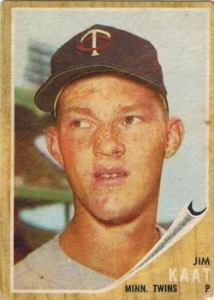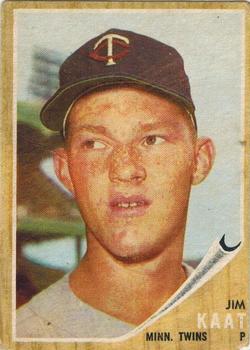July 19, 1962: Kaat shutout, Allison home runs lead Twins to sweep of Cleveland
 A morning downpour threatened to postpone a Thursday afternoon game at Metropolitan Stadium, the Minnesota Twins’ home in their second season after moving from Washington.
A morning downpour threatened to postpone a Thursday afternoon game at Metropolitan Stadium, the Minnesota Twins’ home in their second season after moving from Washington.
Cleveland, the visiting team, may have preferred not to play. It had lost its last six games and eight of its last nine, including a 14-3 drubbing the day before when Bob Allison and Harmon Killebrew of the Twins hit grand slams in an 11-run first inning.1
Cleveland had been in first place in the American League on July 7, but 9 losses in 10 games, including six in a row, had dropped the team into a virtual third-place tie with Minnesota coming into the final game of the three-game series.2 Both teams trailed the first-place New York Yankees by 5½ games.3
To stop the slide, Cleveland turned to right-handed ace Dick Donovan, who had won his first eight decisions of the season and was now looking for his 13th win against three losses. The 34-year-old Donovan, AL Cy Young Award runner-up with the Chicago White Sox in 1957, had a season earned-run average of 2.78. On the mound for Minnesota was 23-year-old southpaw Jim Kaat, who had an ERA more than a run higher than Donovan’s. In his second full season in the majors, Kaat was 8-9, had lost his last five decisions, and had never beaten Cleveland in five starts.
Twins manager Sam Mele had a set lineup of position players for much of 1962: center fielder Lenny Green, first baseman Vic Power, third baseman Rich Rollins, left fielder Killebrew, right fielder Allison, catcher Earl Battey, second baseman Bernie Allen, and shortstop Zoilo Versalles. Green, however, had been out of the starting lineup since jamming his thumb while carrying an outboard motor on a fishing trip during the break for the first All-Star Game,4 and Bill Tuttle (normally a late-inning replacement in the field for Killebrew) was in center field instead.
Minnesota seized the lead in the second on Allison’s one-out homer to left. Battey followed with a double to right, and Allen hit a line drive. But second baseman Jerry Kindall (a native of St. Paul and a former college star for the Minnesota Gophers)5 caught it and threw to shortstop Woodie Held to double off Battey, ending the inning.
Versalles started the third with a bouncer over third baseman Bubba Phillips and hustled it into a double. Groundouts by Kaat and Tuttle brought the 22-year-old Versalles home for a 2-0 lead.
Kaat scattered runners in the first three innings. Chuck Essegian walked with two out in the first, and Phillips reached second on an infield single and wild pitch in the second, but both were left there. Willie Tasby singled with one out in the third, but Killebrew robbed Willie Kirkland of an extra-base hit with a backhanded catch against the fence in the left-field corner, Essegian struck out, and Cleveland remained scoreless.
Kaat retired the side in order in the fourth and allowed only two more runners the rest of the way, Tito Francona reaching on an infield single to start the fifth, and Phillips getting brushed by a pitch in the seventh.
The Twins kept building their lead. Rollins led off the fourth with a grounder to the left of second. Kindall ranged to his right to field it, but Rollins beat the throw to first. Killebrew’s single put two runners on for Allison.
Allison hit a popup near the first-base dugout. Francona, the first baseman, and catcher John Romano converged but couldn’t decide who would take it. The answer was neither, and the ball dropped safely in foul territory. Given another chance, Allison singled to left to bring in Rollins for a 3-0 lead.
After Donovan turned Battey’s sacrifice attempt into a force of Killebrew at third, Allen singled to right to score Allison with Minnesota’s fourth run of the game and send Battey to third.
Cleveland manager Mel McGaha took Donovan out. Bill Dailey relieved and displayed the escape skills – getting Versalles to ground into an inning-ending double play – that ended up making him a fireman ace for the Twins the following season.6
But Dailey couldn’t maintain his magic when he returned for the fifth. With one out, Tuttle singled and stopped at third on Power’s double. The effervescent Power – who had stolen home twice in a game for Cleveland in 1958 – danced off second. Even with a runner ahead of him at third, Power took long leads, enough to draw a couple of pickoff throws from Romano. Rollins hit a sacrifice fly to center that scored Tuttle, with Power also tagging and taking third.
Killebrew – who led the American League with 48 home runs in 19627 – was up. His grand slam in the previous day’s game was part of a two-homer day, and at age 26 he already had a home-run title, three top-five finishes on the AL homer leaderboard, and 154 career long balls to his name, but Power had other ideas. On the second pitch, Power made a move toward home, just as he had danced off second a few minutes earlier.
This time, however, Power didn’t stop. Killebrew feigned a swing to delay a reaction from Romano, then stepped out of the way to give Power a path to the plate.
Romano lunged but couldn’t get his glove on Power’s foot until it had caught the corner of the plate, and umpire Nestor Chylak signaled safe. Power flashed a smile toward his former team in the third-base dugout8 as his steal of home gave Minnesota a 6-0 lead.
Frank Funk, Cleveland’s third pitcher of the game, relieved in the eighth and hit Power with a pitch. The day before, after the first-inning carnage inflicted on Cleveland pitchers, Jim Perry had brushed back Power, which emptied the dugouts after Power approached Perry to express his feelings.9 If Funk had been retaliating for the steal of home, Power didn’t react and just took his base.
Hitting Power turned out to be costly (if not for Cleveland, at least for Funk’s ERA) because, with two out, Allison hit his second home run of the game, and the Twins finished with an 8-0 win, outscoring Cleveland 29-5 in the three-game series.
The win put Minnesota a game ahead of Cleveland and into third place. Two more Cleveland losses in Los Angeles stretched the losing streak to nine. Cleveland finished the season at 80-82, in sixth place (out of 10), 16 games behind the pennant-winning Yankees. Donovan eventually reached 20 wins, but his ERA ballooned from a league-leading 2.40 in 1961 (when he pitched for the Washington Senators) to 3.59, and he never again won more than he lost in the majors.
The Twins kept winning, taking their next two games to extend their winning streak to six, and Minnesota finished in second place, five games behind New York.
After his win over Cleveland, which tied him for the league lead in shutouts (4) with teammate Camilo Pascual, Kaat stayed strong. He finished 1962 with an 18-14 record and brought his ERA down to 3.14. Kaat remained in double figures in wins for the next 14 years, leading the AL with 25 in 1966 and being a 20-game winner twice in the 1970s with the Chicago White Sox. Kaat eventually spent more time in the bullpen and, as a valuable lefty reliever, pitched until 1983, giving him 25 seasons in the major leagues. In December 2021, Kaat was elected to the Hall of Fame.
Author’s Note
This game was the first I ever attended. It was a good one to stimulate the already burgeoning baseball interest in a kid four days shy of his seventh birthday.
Acknowledgments
This article was fact-checked by Kevin Larkin and copy-edited by Len Levin.
Andrew Harner provided coverage of the game from the Cleveland Plain Dealer. To this point I had only a game story from the St. Paul Pioneer Press, and the Minneapolis Star and Tribune were on strike in the summer of 1962. The details from the Cleveland paper – including Romano and Francona botching a foul pop up – added a lot, so I am grateful to Andrew for his help.
Sources
I got my first look at a scorecard at this game but didn’t keep score. It wasn’t until the 1990s, through the magic of Retrosheet, that Dave Smith sent me the play-by-play. This information is now online at:
https://www.retrosheet.org/boxesetc/1962/B07190MIN1962.htm
https://www.baseball-reference.com/boxes/MIN/MIN196207190.shtml
The newspaper stories I relied upon for details were:
Goethel, Arno. “Twins, Kaat Blank Tribe as Allison Cracks Pair,” St. Paul Pioneer Press, July 19, 1962: 14, 16.
Dolgan, Bob. “Indians Drop 7th Straight, 8-0: Twins Pound Donovan,” Cleveland Plain Dealer, July 20, 1962: 25-26.
“Twins Ahead of Crowd Pace,” St. Paul Pioneer Press, July 19, 1962: 14.
Both the Plain Dealer and “Twins Ahead of Crowd Pace” stories note the weather that threatened to postpone the game. Dolgan’s story mention Allison’s pop foul that Romano and Francona let drop between them.
Notes
1 Although it was reported that this was the first time a team hit two grand slams in the same inning, it had happened in the National League in 1890 when Chicago did it on August 16. The Twins’ slams are the only time it happened in the first inning.
2 Cleveland was 48-42, Minnesota 49-43.
3 The Los Angeles Angels were in second place, 3½ games behind New York.
4 Arno Goethel, “Twitchy Twins Find Tailor-Made Crutch in Killer’s Hot Bat,” The Sporting News, July 28, 1962: 29; Goethel, “Stigman’s Strikeout Slants Spur Twins to Winning Splurge,” The Sporting News, August 4, 1962: 14.
5 Kindall played on the 1956 College World Series champions. He later coached Arizona to three titles and became the first person to play on and coach a College World Series winner.
6 Dailey, acquired by the Twins the day before the 1963 season opened, was retroactively credited with 21 saves when saves became an official statistic in 1969. Under an unofficial, and stricter, save rule in 1963, Dailey was credited with 13 saves. He emerged as a fireman for the Twins, its usage much different from latter-day one-inning wonders who rack up large save totals by protecting a lead of up to three runs for one inning. In 1963 Dailey had a 1.99 ERA in 108⅔ innings and became Mele’s reliever of choice when the game was on the line.
7 Killebrew led the majors in homers through the end of scheduled games, but in a three-game National League playoff, Willie Mays of the Giants hit two home runs to pass him.
8 Bob Dolgan, “Indians Drop 7th Straight, 8-0: Twins Pound Donovan,” Cleveland Plain Dealer, July 20, 1962: 26.
9 “Tempers Flare,” Cleveland Plain Dealer, July 19, 1962: 45.
Additional Stats
Minnesota Twins 8
Cleveland Indiana 0
Metropolitan Stadium,
Bloomington, MN
Box Score + PBP:
Corrections? Additions?
If you can help us improve this game story, contact us.


